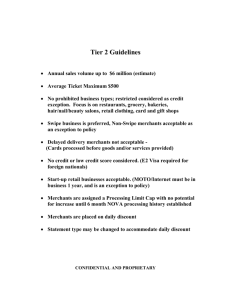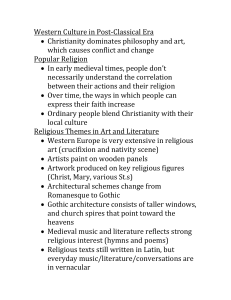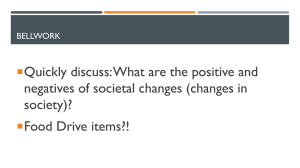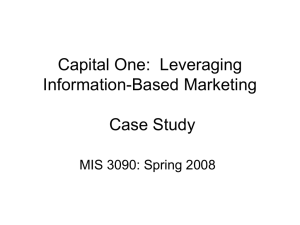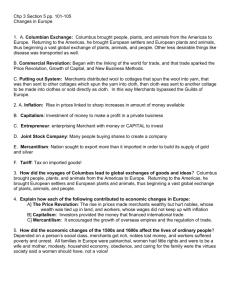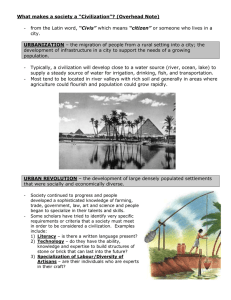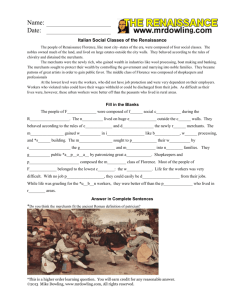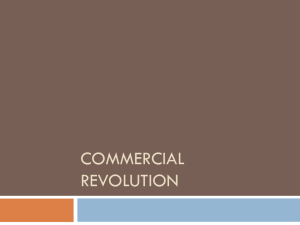Chapter 5: THE EMERGENCE OF CORPORATE MERCHANT-BANKS IN DUGENTO TUSCANY
advertisement
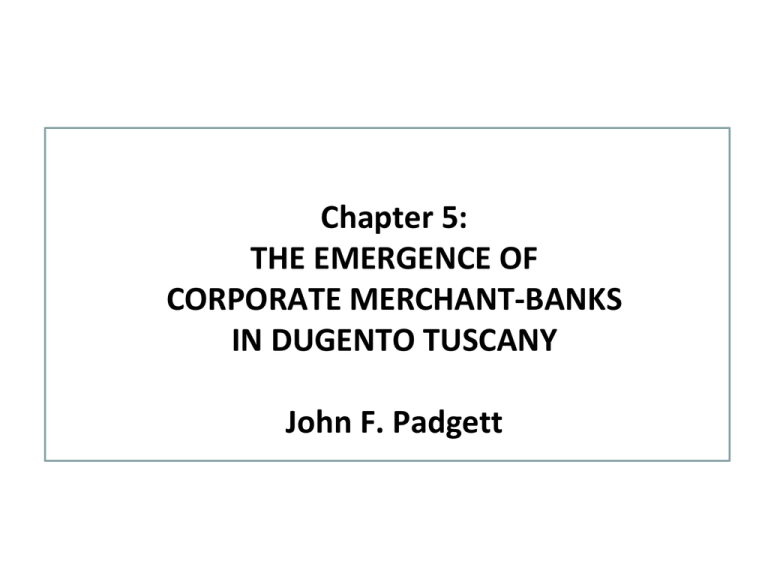
Chapter 5: THE EMERGENCE OF CORPORATE MERCHANT-BANKS IN DUGENTO TUSCANY John F. Padgett Commercial revolution of the 1200s (Lopez, Sapori, de Roover) -- rise of sedentary merchants -- before, in fairs, merchants moved with goods -- branch offices (filiali), connected through writing -- central account book (ragione sociale) -- legal and social continuity through time -- the medieval corpo-ration (società): obligations transcend businessman himself -- often rooted in patrilineage -- examples: Bardi, Peruzzi, Scali, Bonsignori merchant-banks I studied letters in papal registers and writs in English Liberate rolls. New organizational form = Medieval corporation Before: Champagne fairs -- seasonal migration of textiles and merchants -- money-changers to settle coin payments at end of fair After: Italian sedentary merchants -- geographically dispersed offices with (often related) partners as branch managers -- moving goods, not merchants: letters/orders for textiles, and bills of exchange for money -- corpo = startup capital = the body of “corporation” Cultural foundations: the medieval meanings of “corporation” Business becomes body (corpo), like family and church -- no longer just individual merchants and their contracts Multiple medieval meanings of corpo: -- partners’ start-up capital, but with -- legal continuity through time, like church as body of Christ -- unlimited liability, through patrimony of family Practical implication for operations: -- single centralized account book (ragione sociale) -- possibility of written rolling credit Mechanism of Organizational Invention: Incorporation and Detachment In overview: I. Incorporation = Market into Church -- Pope coopted Tuscan merchants from Champagne fairs into papal administration, -- in order to collect military levies for Italian crusades. II. Detachment = from Church to England and new trade -- Tuscan merchants later leave Pope to work for King of England and to trade and process wool. Thus international finance emerged out of organizational hybridization of merchant fair with Church. Consequences of Incorporation Organizational consequences of continued old roots in fairs: -- much liquid money -- techniques: contracts, partnership, deposit accounting Organizational consequences of new incorporation into Church: -- merchants become one wing of crusade militia, in “body of Christ procession” to heaven -- sedentary geographical imprinting: merchants become banking adjuncts of bishops, in order to get their loans back through church admin. -- organizational concepts of corpo and office -- business orders now in written letters, like papal bulls themselves Organizational Birth through Italian crusades Crusader army Military WAR with Holy Roman Emperor Church Religion Detachment Incorporation Economy Tuscan merchant-banks Champagne fairs catalysis: companies into families Kinship . patrician families new-man families Organizational Spillover through Detachment So much for Pope’s creation of temporary organizational novelty, now how did that novelty spill over into transforming international finance and trade? Answer best explained through sequence diagram: -- first transposition to King of England, which triggered -- a second organizational novelty: English customs -- allowing Tuscans to hijack English wool from Flanders to build Florentine textile industry Autocatalytic Spillover Charles of Anjou English army mercenary Pope old levies Tuscan nobles fifths 1 papal administrators Papal assets (bishops) King of England 5 patrilineage crusades levy loans feudal levies 2 Tuscan merchants m-b wool textiles loans m-b English customs wool recruitment 4 3 Champagne fairs wool textiles Florentine textile manufacturers textiles textiles Customers (merchants + wealthy) = resource flow = organizational link Flemish textile manufacturers English assets (vassals) Final autocatalytic spillover into kinship: Florentine patrilineage Not “family into company” but “company into family”: -- cf. Thomas Blomquist (contra Sapori) Merchant new men (and their syndicates) turned themselves into noble patrilineages -- using plastic social form of consorteria -- with recognition and support from their new customers: Church, bishops, kings and aristocrats Italy thereby moved onto separate evolutionary trajectory from France and most of Europe: -- merchants and nobility blended, not segregated General Conclusion Inventions of new organizational forms in Padgett & Powell book are generated through A. Recombination of multiple types of social relations across multiple-network domains -- We call this innovation plus B. Reproduction through autocatalytic spillovers that tip networks in those domains -- We call this invention This is social-network perspective on evolution.
